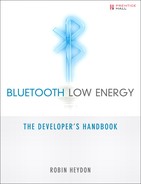Preface
Sometimes, once in a lifetime, a new technology comes along that changes the world; for example, AM radio, television, and wireless Internet. Bluetooth low energy is at the cusp of the next revolution in wireless technology: a technology that can be embedded in products because it uses so little power that it can be designed around a small battery that lasts for years.
This book explains how this technology came about, why it was designed the way it has been designed, and how it works. It is written by one of the leading experts on Bluetooth low energy, Robin Heydon, who has been involved in creating the specifications, interoperability testing, and training.
This book is for anyone who is thinking about developing a product that incorporates Bluetooth low energy, whether you are an engineer, an application developer, a designer, or you’re in marketing.
For engineers, the book covers the details of how the complete system works, from the physical radio waves up to the discovery of, connection with, and interface provided by that device.
For application developers, this book provides an understanding of the constraints imposed by Bluetooth low energy on applications. It also presents a thorough description of the design goals and implementation of these requirements.
For designers, the information contained herein will allow you to appreciate the particular problems with designing Bluetooth low energy wireless products, from how the product might need to work and how big a battery might be required to implement your ideas.
For everyone else, the book provides the background of why Bluetooth low energy was designed, the design goals it tried to achieve, and how you can take something that radically changes the way you can think of wireless technology and implement it in everything else.
The book is split into four parts:
Part I provides an overview of the technology, the basic concepts that guided the development of Bluetooth low energy, the architecture of the system from the radio through the various protocol layers up to the application layers, and finally, the new usage models that this new technology enables.
The second part goes into detail on how the radio chip—called a controller—functions. This is the silicon chip that product designers need to incorporate into their end products. This part also covers the radio, Direct Test Mode, and the Link Layer. In addition, it shows how to interact with the controller from the upper-layer stack, called a host.
Part III goes into detail of how the host (the software stack) works. It covers the concepts and details behind the main protocol used to expose attributes of a device. It also covers the security models and how to make connections and bonds, or associate, two devices with one another.
In Part IV, you wrap up all the details by looking at the design considerations that a product or application developer needs to consider. It starts by looking at the issues involving central devices. Next, it looks at issues related to peripheral devices. Finally, it considers the entire problem surrounding testing and qualification, typically the final part of any product that will be taken to market.
If after reading the book you would like to learn more about Bluetooth low energy, there are a number of resources available. The specifications themselves are available on the Bluetooth SIG website at www.bluetooth.org. If you would like to find developer information about Bluetooth low energy, there is also a developer site available at developer.bluetooth.org that has detailed information about characteristics. The author also has a website at www.37channels.com, where you can view frequently asked questions raised by this book and Bluetooth low energy.
